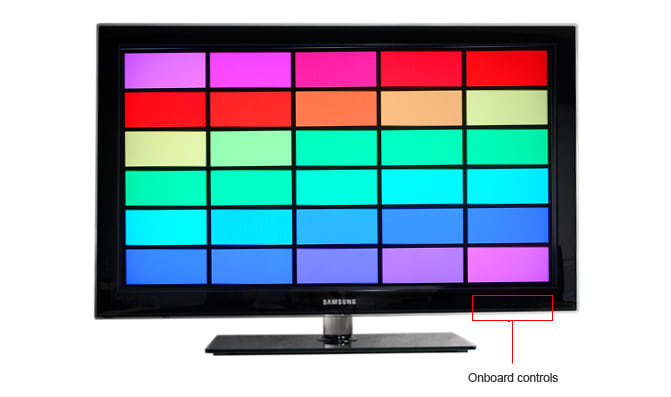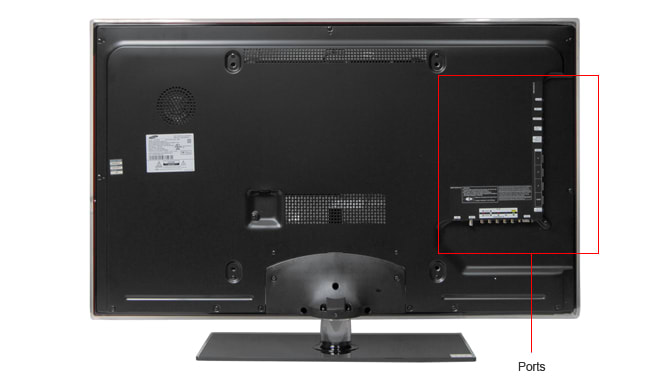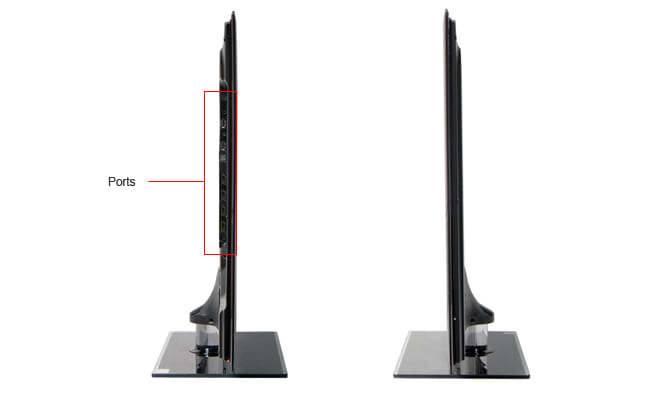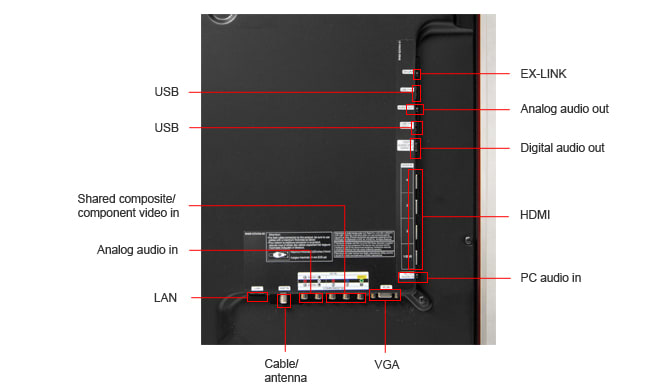Introduction
Tour & Design
The Samsung UN40C5000 is an attractive TV. The bezel is not necessarily thin, but it seems to blend in well with the screen. The thin, translucent neck and flat, highly polished base rounds out the eye-pleasing design. There are a series of touch-sensitive controls along the bottom of the bezel. It attracts a lot of fingerprints, so we recommend sticking with the remote.

The back of the Samsung UN40C5000 houses all the ports, arranged in an L-shape on the back. For information about the ports on the back see our Connectivity section.

The Samsung UN40C5000 is quite thin, as you can see in the photos. For information about the ports on the sides see our Connectivity section.

The Samsung UN40C5000's stand is wide and flat, with a high gloss sheen. It connects to the TV panel with a series of screws that make it feel very secure. The stand also allows the the panel to swivel back and forth.
The onboard controls are a series of touch-sensitive buttons along the bottom of the bezel. Because the glossy frame attracts so many fingerprints, we prefer it when the buttons are on the side of the TV.
The remote control is pretty standard. It's lightweight and feels cheap. We really like the backlight feature that allows you to operate it a little easier in dark rooms.
The Samsung UN40C5000 ships with a base and requisite screws, remote control, batteries, instruction manual, and various other documents. We were disappointed to see that on our particular unit, the bezel had started to break away from the chassis. It didn't really compromise the structural integrity because the bezel does not have to bear any weight. But it didn't give us confidence, either.
The Samsung UN40C5000 is a good looking TV, for the most part. Samsung's trademark "Touch of Color" is present here, offering a reddish hue. It's a lot more subtle than last year's red, which some of us found a tad repulsive. This year, it's just a thin border between the black part and the completely translucent part.
Blacks & Whites
The Samsung UN40C5000 produced a very good black level, dipping as low as 0.06 cd/m2. As you can see from the chart below, it's the best performer in the comparison pool we've created. (More on how we test Black Level.)
The Samsung UN40C5000's maximum brightness is more than sufficient for most kinds of TV viewing, even in a bright room. (More on how we test Peak Brightness.)
The Samsung UN40C5000's contrast ratio is an outstanding 5380:1. That may not match up to the scores that the manufacturer provides, but out methods are a little more like what you'll experience in everyday viewing. (More on how we test Contrast.)
The Samsung UN40C5000 showed no significant problems with maintaining a consistent black level. (More on how we test Tunnel Contrast.)
The Samsung UN40C5000 showed no problems at all with maintaining a consistent peak brightness. (More on how we test White Falloff.)
The Samsung UN40C5000 showed some minor issues with screen uniformity. We noticed that when looking at a flat, black screen, you can see blotches of brighter spots. On an all white screen, the corners are noticeably yellower and dimmer. (More on how we test Uniformity.)
The greyscale gamma measures how well a TV transitions from black to white. From the chart below, we can see that the Samsung UN40C5000 has a pretty smooth response curve. The lower-left portion, which represents the shadow details, has some squiggles that could mean loss of detail. There's also the general slope of the curve. An idea slope is between 2.1 and 2.2. The Samsung UN40C5000's curve of 2.6 is a little steep, so you'll be missing some of the finer transitions in the greyscale. Overall, though, it's a good performance. (More on how we test Greyscale Gamma.)
Color Accuracy
The Samsung UN40C5000 did not do very well in maintaining a consistent color temperature. As you can see in the chart below, for large stretches of the signal range the color temperature warms considerably. The low score it received is because the error is noticeable and takes place over a wide portion of the signal range. (More on how we test Color Temperature.)
The Samsung UN40C5000 performed moderately in the RGB color curves test. As you can see from the chart below, the red and blue response curves have a lot of wiggles and bumps. Each of those could represent an instance in which the TV screen would show some color banding. Also note how the red and blue channels stop short and become horizontal in the upper-right portion. This indicates that the TV has a lot of trouble displaying details in the highlights. It's a big problem that we verified with our own eyes in other testing. (More on how we test RGB Curves.)
The good news is that the green channel performed very well. That could mean that sports turf could look great.
The strips below are digital recreations of the information from the same test. Note how the Samsung UN40C5000 performs against the three competing TVs, as well as an ideal response.
The Samsung UN40C5000 did not match up all that well to the rec. 709 color standard, a common industry standard. The green point is pretty close to the mark, the red point is more off, and the blue point is way off. (More on how we test Color Gamut.)
The table below contains all the hard data from the test and how it measures up to rec. 709.
Motion
The Samsung UN40C5000 produced a nice, smooth motion. Objects showed the normal amount of fine detail loss, which we'll talk about more in the section below. This TV does not have the motion smoothing features of the more expensive Samsung TVs, but we always recommend leaving them disabled anyway. (More on how we test Motion.)
The Samsung UN40C5000 displayed a lot of artifacting when objects are in motion. The most egregious is that shapes with straight vertical lines become diagonal when in motion. As near as we can reckon, it's a result of sluggish processing. There were also instances of false color trailing and flickering.
The Samsung UN40C5000 has no problem displaying native 24fps content, like you'd find on most Blu-Ray discs. In the TV's menu, there's an option called Film Mode. Make sure it's set to "Auto 2" for best performance. (More on how we test 3:2 Pulldown and 24fps.)
The Samsung UN40C5000 has a native 1080p resolution (1920 x 1080), but much of the content you watch will be of a lower resolution. It's up to the TV's internal processing to scale that video to fit its own screen. (More on how we test Resolution Scaling.)
480p
When displaying 480p content, the Samsung UN40C5000 lost 2% of the top and bottom and 3% of each side due to overscan.
720p
With 720p content, there was no loss due to overscan. We noticed a few problems with Moires in high frequency patterns, but it was minor.
1080i
When looking at 1080i content. we noticed some of the same Moire appearing in high frequency patterns.
Viewing Effects
The Samsung UN40C5000 has a native 1080p resolution, and can play back all NTSC formats.
The Samsung UN40C5000 has a viewing angle of approximately 45 degrees in total (22 degrees from center in either direction). This is not great, but it's about average for an LCD TV. (More on how we test Viewing Angle.)
The Samsung UN40C5000 has a wide, diffuse reflection when a light is shining directly on it. If you can change the angles by moving the TV or the light, you should be able to reduce the glow until you won't even notice. (More on how we test Reflectance.)
The Samsung UN40C5000 has many video processing features, though you'll only want to bother with a couple of them.
Calibration
[

](http://www.displaymate.com/)To get the best performance from the Samsung UN40C5000, we started by putting in in Movie mode, then making some tweaks from there.
If you don't see a processing feature listed above, assume that we put it in the "off" position.
The Samsung UN40C5000 has four preset modes. We recommend using Movie mode for the best color performance.
Remote Control

Ergonomics & Durability*(6.0)*
The Samsung UN40C5000 ships with the same remote as several other Samsung HDTVs, including the LN40C630 and other 2010 LCD units. The design is adequate. It's not impossibly stylish as the remote that comes with high-end Samsungs, which is probably for the best. This is light, cheap, and easily replaced with a universal remote.
The buttons are made of a gummy rubber material, except for the d-pad in the center, which is a hard plastic. That orange button in the upper-right activates a backlight feature that makes the remote easier to use in the dark.
Programming & Flexibility*(1.0)*
The remote can be used on other Samsung AV devices bearing the Anynet+ logo, but it's not a fully programmable universal remote.
Connectivity
The Samsung UN40C5000 has a number of ports, all of which live on the back of the TV in an L-shape, as you can see in the picture below. Notable selections include 4 HDMIs, 2 USBs, and a LAN port for home networking. Note, however, that the LAN port is for DLNA connections only, and doesn't include access to streaming content from the web like more expensive Samsungs.

The table below shows how the Samsung UN40C5000 compares to similar TVs.
The Samsung UN40C5000 has an analog audio output and a digital audio output, as is standard for most HDTVs.
The Samsung UN40C5000 has a LAN port for wiring the TV to a home network with DLNA. There's also an EX-LINK port.
The Samsung UN40C5000 has two USB ports. Both of them can handle USB thumb drives, and one of them can read standard, full-sized hard drives. For more information about the multimedia capabilities, jump ahead.
The port placement on the Samsung UN40C5000 is perfectly adequate. The L-shape certain allows better access to the ports facing the side than those facing the bottom, but because the TV panel can swivel on its base, it's not to hard to see everything back there.
Audio & Menus
The Samsung UN40C5000's audio performance was, on the whole, about what we'd expect for mid-priced HDTV. Peak performance is rarely (perhaps "never" is a better word) at the forefront of a TV manufacturer's concerns. It's generally assumed that if you want better performance, you'll simply buy a dedicated 5.1 or 7.1-channel audio system. The performance of the built-in speakers is fine for everyday TV watching, but the complete lack of bass response makes movie watching a bit lackluster.
The TV's menu offers a handful of audio presets: Standard, Music, Movie, Clear Voice, and Custom. There's a small but potentially useful equalizer, if you're into creating your own mix. The TV also features a surround sound emulator, though we found it a far cry from an actual surround sound system.
The Samsung menus are similar across nearly their entire HDTV line, which certain features added or dropped depending on the model. Overall, it's a great, easy to use system that present the maximum amount of information on the screen at any give time so you don't get lost down a rabbit hole.
The instruction manual that ships with the Samsung UN40C5000 is quite comprehensive, as far as manuals go. It has a table of contents and a alphabetical index, so you should be able to find everything you need quickly.
Multimedia & Internet
The Samsung UN40C5000 has a LAN port that allows you to connect to a local network using DLNA. However, the LAN port does not give you access to Samsung's online content offerings, as you might have seen on more expensive models. For that, you'll need to step up to the C5 series or higher.
Through the USB ports that read both USB thumb drives or full-sized hard drives, you can display photos on the Samsung UN40C5000's screen. The menu allows you to view photos in a series of thumbnails, one at a time on a full screen, or create a slideshow.
The Samsung UN40C5000's USB ports also allow you to play music and video files. The interface is hardly as elegant something like iTunes, but it works well enough.
The Samsung UN40C5000 does not support any other type of media.
Power Consumption
The Samsung UN40C5000 does not require much power to run. Our test data, in the table below, shows that even at a maximum backlight setting, it costs only $16.05 per year, on average. At a more modest backlight setting, it costs justs $12.14. (More on how we test Power Consumption.)
The table below shows how it compares to similar TVs.
Vs Sharp LC-40LE700
Value Comparison Summary
The Sharp LC-40LE700 lacks some of the more advanced features found on the Samsung UN40C5000, yet it costs more than the Samsung. In its favor, we did find that it performed better in several key areas. However, the sheer experience of operating a Samsung is generally preferable to operating a Sharp. The menus, the remote control, and the overall look and feel is simply of a higher quality in the Samsung. That said, let your wallet be your guide. If you can find a better deal on one or the other, you can be confident knowing that there's no enormous gain that one has over the other.
Blacks & Whites
The Samsung's black levels, white levels, and contrast ratio are far better than the Sharp.
Color Accuracy
The Sharp LC-40LE700 was much better at maintaining a consistent color temperature, as well as performing in our RGB color curve test.
Motion
The Samsung and Sharp were on equal ground at producing motion smoothness, but the Samsung showed more artifacting.
Viewing Effects
Neither TV was particularly good at producing a wide angle. Most LCD TVs fail in this regard, and you'll have to turn to a plasma TV if you want decent performance in this area.
Connectivity
The Sharp offers more ports for people looking to plug in traditional video sources like VCRs and DVD players. The Samsung is far superior for "new media" like DLNA home networking and USB hard drives.
Vs Sony KDL-40NX700
Value Comparison Summary
The Sony KDL-40NX700 retails for slightly more than the Samsung UN40C5000, but online prices will likely vary. The Sony offers excellent picture quality, along with built-in WiFi and streaming content. The Samsung requires a separate purchase for WiFi connectivity and offers no streaming content (though they both have DLNA home network support). Overall, if you can find the Sony for less, it's the better deal.
Blacks & Whites
The Sony KDL-40NX700 could not match the Samsung's black level performance. Despite some advantages in screen brightness, the Samsung's contrast ratio remains the best in this pool.
Color Accuracy
The Sony KDL-40NX700 definitely did not have the problems that the Samsung displayed with maintaining a consistent color temperature. The RGB color curves were also smoother.
Motion
The Sony KDL-40NX700 showed some slight advantages in motion performance by producing a smoother image with less associated artifacting.
Viewing Effects
The Sony KDL-40NX700 and the Samsung UN40C5000 are both LCD TVs, and as such they don't offer a great viewing angle.
Connectivity
The Sony KDL-40NX700 offers more traditional AV device connection points, while the Samsung focuses on "new media" ports like two USBs, one of which can read full hard drives. We have to had this win to the Sony, however, as it offers built-in WiFi and a LAN for DLNA home theater and streaming content. The Samsung requires a separately purchased adapter for WiFi, and offers DLNA support only, not any streaming content.
Vs Samsung LN40B650
Value Comparison Summary
The Samsung LN40C650 is a 2009 model. It's a little fatter than the new C5000, and not quite as stylish. However, it's probably available cheaper, and its ampler chassis offers more room for ports. The C5000 features an LED backlighting rather than the CCFL backlighting on the B650, but we saw no huge advantage with LED. Don't be fooled that newer is necessarily better.
Blacks & Whites
The Samsung LN40B650 showed nearly identical performance in the black levels, peak whites, and contrast ratio. Both are excellent performers.
Color Accuracy
The Samsung UN40C5000 showed noticeable problems with maintaining a consistent color temperature that last year's LN40C650 did not.
Motion
Both Samsungs do a good job at showing smooth motion, but are problematic when it comes to excessive artifacting around moving objects.
Viewing Effects
The viewing angles on both Samsung TVs is disappointing.
Connectivity
The Samsung C5000 series is considerably slimmer than the B650 series, which meant less room for ports. However, the newer C5000 offers WiFi connectivity, albeit requiring a separate purchase and allowing only DLNA support, not access to Samsung's great line-up of streaming content.
Conclusion
Series Comparison
C5000 Series
There are five models in the C5000 series, making it one of the larger series out there. There is no difference in features (i.e., all have a LAN port and DLNA home networking, the same remote control the same basic design, etc.). Only the size changes.
Meet the tester
David Kender oversees content at Reviewed as the Editor in Chief. He served as managing editor and editor in chief of Reviewed's ancestor, CamcorderInfo.com, helping to grow the company from a tiny staff to one of the most influential online review resources. In his time at Reviewed, David has helped to launch over 100 product categories and written too many articles to count.
Checking our work.
Our team is here for one purpose: to help you buy the best stuff and love what you own. Our writers, editors, and lab technicians obsess over the products we cover to make sure you're confident and satisfied. Have a different opinion about something we recommend? Email us and we'll compare notes.
Shoot us an email
